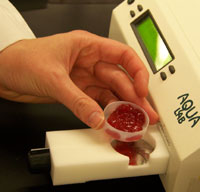Physical Properties
 Physical properties analyzed in food include the following:
Physical properties analyzed in food include the following:
Water activity (Aw)
This determines how much water is available for microbial growth. The lower the water activity, the less chance for microbial spoilage. This is not the same as water content. Foods with the same water content may have different water activity. This property affects odor, color, flavor, texture and shelf-life. If not controlled, the quality and safety of the food will suffer. The Aw is measured using a water activity meter. The water activity value for pure water is one, therefore other foods should have a value of less than one.
| Water Activity Level | Food Products |
| >0.98 | Fresh meat and fish, milk, canned vegetables |
| 0.98-0.93 | Evaporated milk, bread, lightly cured meats |
| 0.93-0.85 | Semi-dry salami, sausage, mature cheese, sweetened condensed milk |
| 0.85-0.60 | Dried fruit, jams and jellies, dried salt fish |
| <0.60 | Chocolate, dried milk, biscuits |
Moisture Determination
This is measured by direct or indirect methods. The direct method removes moisture from the product by oven drying, desiccation, distillation, extraction and other physicochemical techniques. Its quantity is found by weighing. This method is accurate but time consuming.
The indirect method is a continuous measurement and automatic control of moisture content in food processing. This method takes very little attention and time to control moisture content. An example is the dielectric method, in which the moisture foods is determined by measuring the change in resistance to an electric current passed through a sample.
| Food Product | % Moisture Content |
| Fresh Fruits | 81-93 |
| Vegetables | 90-95 |
| Meat, Poultry and Fish | 58-68 |
| Nuts | 1.5-3 |
| White Bread | 35 |
| Flour | 12 |
| Corn Flakes Cereal | 3.8 |
| Crackers | 4.3 |
| Macaroni | 10.4 |
Temperature
Accurate temperature measurement is an important indicator of food safety and food quality. Calibration is important to keep thermometers accurate. Here are some guidelines for thermometer calibration:
- Thermometer Calibration Guide (pdf) - Kansas State University
- Thermometer Calibration Poster (pdf) - Kansas State University
Brix Value
Soluble solids are measured by a refractometer and expressed as degrees Brix which is equivalent to the percentage by weight of sugar. Brix is an important parameter for production of fruit juices. Brix is also an important quality control check for jams and jellies. In a finished product soluble solids, as determined by refractometer at 20°C, must be at least 65 percent for jams and jellies. Brix is also important in controlling microorganisms in foods. The higher the Brix, the less water available for microorganisms to grow, since the sugars are bound to the free water.
Salt Determination
A liquid-chromatographic technique generally is used for the analysis of inorganic anions and cations. Typically, ion chromatography is used in the food industry to analyze for amines, organic acids, bleaching agents, nutrients, preservatives and salt content. The range of food products evaluated by the technique includes beverages, breads, dairy products, dried fruits, meat products and processed products.
Viscosity
Temperature is a factor that can easily affect the viscosity of certain foods. Viscosity measurement under different temperature and sheer conditions is important, since in most processes, control applications and accurate monitoring and blending of liquid is a quality control checkpoint. Most viscosity measuring units commercially available use an electromagnetic measurement principle to monitor viscosity (in centipoise) and the temperature (in °C) and are insensitive to vibration and orientation.
Color Measurements
Color measurements can be used to predict visual and chemical changes in foods, an important criterion used to evaluate quality. HunterLab® instruments are widely used in color determinations of foods. These measurements are expressed as "L," "a" and "b" color values. These values are coordinates of the three-dimensional color space. The "a" value measures redness when "positive" and greenness when "negative." The "b" value measures yellowness when "positive" and blueness when "negative." The L-value measure lightness from 0 to 100 or the amount of light reflected or transmitted by the object.
There are also in-process color measurement systems. They are designed to monitor and control the color of processed foods, such as baked goods, snack foods, confectionery products and beverages. This system has no exposed or moving parts and is impervious to heat and humidity.